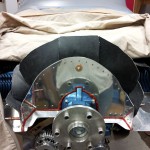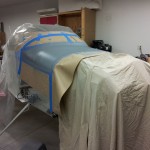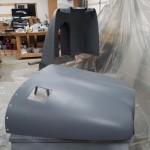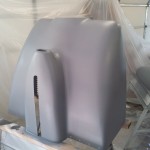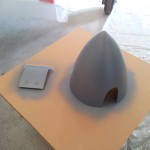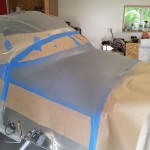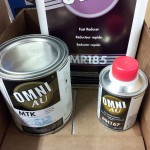All in a day’s work
Hours: 9.5 | Posted in Cowling & BafflesToday’s goal: get the spraying started on the cowling. To do that, first I needed to finish sanding the side hinge joint gaps. Lots of on-off of the top cowl as I slowly whittled the gap open, then once it was close, used a thing sanding tool (paper glued to a thin metal strip) to create a straight, even gap.
Next up was addressing the forward baffle airseal. I’ve tried a couple iterations of this and been unhappy, so this morning I saved a bunch of pictures of different builders’ solutions — not one the same, mind you. With a concept in my head, I tried a couple things and settled on one that seems to work, matching up with the curves of the cowling and inlet ramps. I still need to file the front of the baffle where I trimmed it, rivet these in place, and stitch together a couple of the overlapping “paddles” of airseal. More on-off of the cowling as this process progressed.
Nextly, masked off the forward top skin — aka “boot cowl” — sanded, and cleaned it in prep for primer. Took the cowls and spinner outside and gave them a thorough wash with Dawn and lots of water. Covered up the canopy with plastic and the engine with a dropcloth.
Once the cowls were dry and wiped once more with a microfiber cloth, set up the sawhorses and plastic drape, and mixed up a batch of DPLF primer. Sprayed the oil door, spinner, both cowls inside & out, top skin, and canopy fairing (again, because it had suffered several large scratches during installation). Left that to dry while I ran to town to pick up some spot putty and topcoat paint.
Came back and attacked the remaining pinholes with fast-setting (20 min) spot putty. Once dry, sanded off everything but the tiny bit inside the pinhole. Resprayed DPLF over the sanded areas. Tomorrow night–assuming I escape from work at a reasonable hour–the exterior of the fiberglass parts will be sprayed with K36. The inside of the cowls will be sprayed with the paint I picked up, PPG Omni acrylic urethane, single-stage two-part. This will seal up the surfaces against oil, and the white color will increase visibility under the cowl, and make leaks easy to spot.
